Palazzo Barberini ( Barberini Palace ) and Corsini Gallery
National Gallery of Ancient Art in the Barberini Palace
Palazzo Barberini and Galleria Corsini are one museum divided into two galleries (National Gallery of Ancient Art). The Palazzo Barberini, one of the most beautiful Baroque palaces of the 17th century, was designed by some of the finest architects of the time, namely Carlo Maderno, Gian Lorenzo Bernini, and Francesco Borromini. Maffeo Barberini commissioned Maderno in 1625 to renovate a villa on Quirinal Hill he bought for his grandchildren, two years after being elected pope as Urban VIII. With open wings, Maderno created a vast yard filled with rare plants, secret courtyards, and Italian-style gardens. There is a majestic reception hall frescoed by Pietro da Cortona at the heart of the palace. There are many painters whose works are on display in the museum, including Raphael, Caravaggio, Titian, Tintoretto, Poussin, and El Greco.
A brief history of Palazzo Barberini
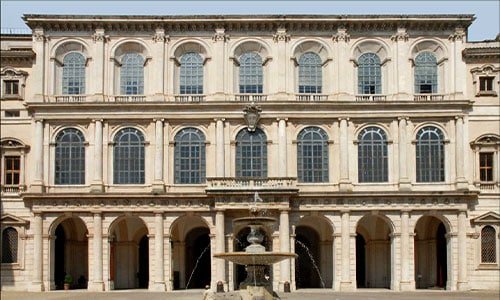
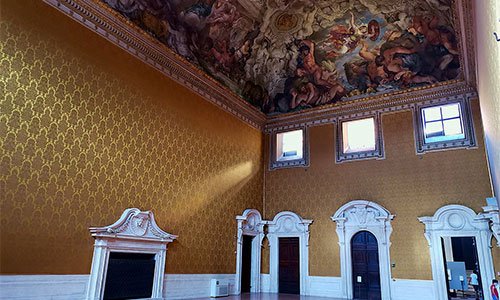
Palazzo Corsini’s history begins in 1511 with the construction of a building on Via della Lungara. In 1655, the Swedish Queen Christina moved to Rome after converting to Catholicism, and the original building was modified between 1659 and 1689 to become her residence. She was a cultured woman who loved the arts and used the palace as a gathering place
It is a meeting place for intellectuals and artists in the city. In order to organize the palace, she ordered the ground floor to house a collection of statues while the main floor would house a gallery of paintings.
The Corsini family acquired the building when Lorenzo Corsini became pope in 1736 and took on the name Clement XII. The wealthy Florentine family needed a grand residence to display their new status. The building was therefore restructured and expanded by architect Ferdinando Fuga.
The Galleria Corsini became the first national gallery of Italy when its collections were donated to the newly-formed Kingdom of Italy in 1883. As part of the Galleria Nazionale d’Arte Antica, the Palazzo Barberini became a museum in 1953.
There are masterpieces in Palazzo Barberini and Galleria Corsini, such as the Annunciation by Filippo Lippi, Judith and Holofernes by Caravaggio, Raphael’s La Fornarina, the Allegory of Divine Providence fresco by Pietro da Cortona, and a bust of Urban VIII by Bernini, as well as works from the 17th and 18th centuries in these collections.
References: Wikipedia
You may want to check out these options if you are interested in skip-the-line tickets, guided tours, or a Rome combined ticket if you want to avoid the lines
Why visit Palazzo Barberini
Rome’s Palazzo Barberini is the seat of the Galleria Nazionale di Arte Antica (National Gallery of Ancient Art) and a must-see for art and architecture enthusiasts. Take a look at the following guide to find out which artworks in the collection you need to see!
1. Pietro da Cortona – Allegory of Divine Providence
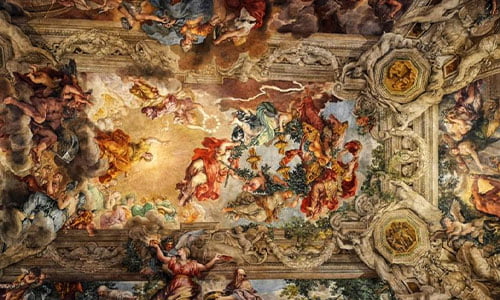
There is one painting that has been in the Barberini collection since the beginning that stands out. In 1632, Urban VIII commissioned Tuscan artist Pietro da Cortona to immortalize the fame of the commissioning family in the yawning great hall of Palazzo Barberini. This composition is a masterpiece of Baroque painting, which dematerializes the ceiling of the Salon in an illusion that defies logic.
2. Raphael – La Fornarina
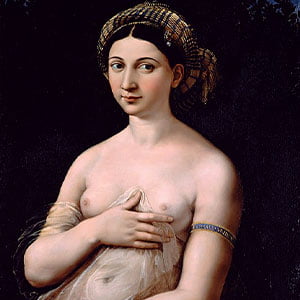
This portrait was painted of Raphael‘s inspirational muse and mistress, Margherita Luti, the daughter of a baker in Trastevere. There is no record of any commission for this work, which supports the theory that Raphael painted it for himself in his final years.
Whether Raphael’s mistress was Venus or not, behind this imperfect face with marked features lies an image of her. With her hands on her lap and on her breast, she mimics the classic statue of the “Venus Pudica“: a gesture of modesty that draws attention to what she is actually concealing. In addition to the bracelet, which bears the artist’s signature and is a symbol of love, the goddess of love is also represented by a token and a pledge of love inscribed with “Raphael Urbinas.”. In the background, a myrtle bush and a quince branch symbolize fertility.
3. Caravaggio ( Michelangelo Merisi ) – Judith Beheading Holofernes
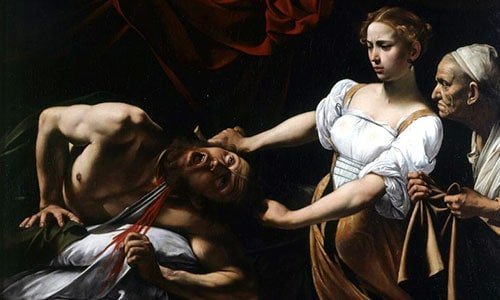
With just three figures and a red drape in the background, the viewer is treated to an utterly realistic theater of contrast: darkness and light, youth and age, death and life, strength and weakness.
A young Jewish widow named Judith is one of the heroes of the Old Testament, a woman who saved her people from the besieging Assyrian army. Having been welcomed to Holofernes’ camp with a festive banquet, she pretended to join the enemy and slew their general with her own hands.
Since the 1400s, iconography had been common, but it had never been depicted so harshly.
Holofernes’ throat is slashed deep by a scimitar. There’s still life flowing through Holofernes’ contracted limbs and hands, though it’s not going to last very long. A strangled cry emanates from the general’s mouth, and we see the blood spurting from the general’s body as if Caravaggio wanted to freeze an act that cannot be stopped.
An Italian banker commissioned the work and stipulated in his will the work’s inalienability. Paintings of this type were lost for several centuries, and only in 1951 was the acclaimed art critic Roberto Longhi able to discover it in a family’s possession, by chance, a dramatic event in keeping with its theatrical nature. Italian state acquired it twenty years later and exhibited it in Palazzo Barberini.
4. Hans Holbein the Younger – Portrait of Henry VIII
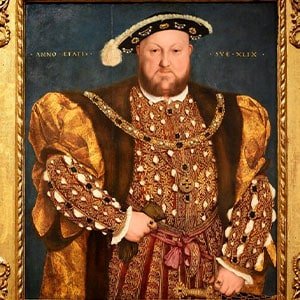
You might be surprised to learn that the most iconic depiction of England’s most notorious monarch isn’t to be found in Buckingham Palace or London’s National Gallery but in the gilded surrounds of Palazzo Barberini. He was appointed to Henry VIII‘s Tudor court as a painter in 1536 by the German artist Hans Holbein the Younger. For the privy chamber in the Palace of Whitehall, he created a portrait of the ruler quickly. In 1698, the famous work was destroyed in a fire but survived in this exquisite version.
With Henry attired in the luxurious finery appropriate to his station, Holbein’s magnificent depiction perfectly demonstrates the autocratic power and grandeur that came with any Renaissance king and offers a fascinating window into the Reformation court’s world.
5. Caravaggio – Narcissus
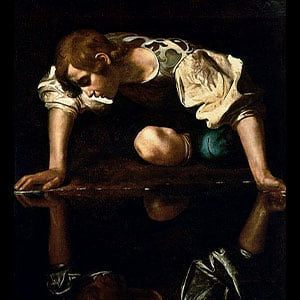
Narcissus is a classical myth that has been depicted numerous times since antiquity. Caravaggio‘s version is distinguished by an unusual composition scheme: the lower half of the canvas is a mirror image of the upper, as if the painter turned the upper part of the canvas 180 degrees to obtain the reflected image of the figure. In the story of the young hunter, his image mirrored in the water led him to fall in love.
Visually pivoting around the naked knee is the painting’s puffed sleeves, while the hand submerged in water is guided by the puffed sleeves. As recounted in Book III of Ovid’s Metamorphoses, Narcissus seeks vainly to embrace the beguiling form of his image. Having realized the paradoxical nature of his love, Narcissus wastes away on the verge of spring with his lips parted.
How to visit Palazzo Barberini
On weekdays, you can get tickets at the main entrance and visit the courtyard, the palace’s permanent collection, the temporary exhibition, and Borromini’s staircase.
Palazzo Barberini is open Tuesday through Sunday (10 am – 6 pm). The last entrance is at 5 p.m. Monday, December 25th, and Monday, January 1st is closed
It is not possible to obtain admission on weekends and public holidays without a reservation.
Here you can book tickets to the museum, or here you can book a private tour.
You must book tickets separately to visit the Mithraeum.
Galleria Corsini
As part of your entrance ticket, you will also be able to visit the art collection in Palazzo Corsini, which has been preserved as much as possible to its original appearance during the 18th century.
Palazzo Barberini tickets price 2024
Palazzo Barberini –
– Full Ticket: € 12 (The ticket is valid for 20 days to visit Galleria Corsini)
– Reduced Ticket: € 2 (EU citizens between 18 and 25 years of age. The ticket is valid for 20 days to visit Galleria Corsini)
– Free: Visitors under 18 years old; Groups of EU school students and their teachers (reservations required); EU faculty members and students in Architecture, Humanities (archaeological or art-historical courses), Cultural Heritage, Educational Science, Fine Arts Academies; MiBACT employees; ICOM members; tour guides with valid ID; journalists with valid press card; people with disabilities and one companion-help).
Notice to the public: reservation is mandatory on weekends and public holidays to access Palazzo Barberini and Galleria Corsini. Buy your tickets here.
FOR GROUPS
Groups are admitted for a maximum of fifteen people, guide included, and are always required to book in advance by contacting the number +390632810
It is mandatory the use radio-transmitter systems during the visit, which can not last more than 2 hours.
ACCESSIBILITY
Parking is available for people with disabilities.
Entrances without architectural barriers. Ramps for wheelchairs, next to the ticket office, leading to the ground floor exhibition rooms and an elevator giving access to first-floor exhibition rooms.
Galleria Corsini –
– Full Ticket: € 12 (The ticket is valid for 20 days to visit Palazzo Barberini)
– Reduced Ticket: € 2 (EU citizens between 18 and 25 years of age. The ticket is valid for 20 days to visit Palazzo Barberini)
– Free: Visitors under 18 years old; Groups of EU school students and their teachers (reservations required); EU faculty members and students in Architecture, Humanities (archaeological or art-historical courses), Cultural Heritage, Educational Science, Fine Arts Academies; MiBACT employees; ICOM members; tour guides with valid ID; journalists with valid press card; people with disabilities and one companion-help).
Notice to the public: reservation is mandatory on weekends and public holidays to access Galleria Corsini and Palazzo Barberini. Buy your tickets here.
QUESTIONS AND ANSWERS
Where is Palazzo Barberini and how to get there?
Palazzo Barberini is located in Rome’s city center on Via Delle Quattro Fontane. There is a short walk from Piazza Barberini to the palace on Quirinal Hill. Bus routes 53, 61, 62, 63, 80, 81, 83, 160, 492, 590 serve the area. Metro line A, Barberini, is the closest metro station.
Is Palazzo Barberini worth visiting?
Even one of them alone is worth a visit to the Palazzo Barberini. This museum is located inside a magnificent 17th-century baroque palace. In addition, it’s completely renovated and unapologetically grand. Barberini’s impressive collection of art is displayed against the backdrop of the palace.
USEFUL INFORMATION
Opening days and times 2024
Palazzo Barberini:
From Tuesday to Sunday from 10:00 am to 6:00 pm
Last admission at 5:00 pm
Closed on: Monday, December 25th, January 1st
Galleria Corsini:
From Wednesday to Monday from 10:00 am to 6:00 pm
Last admission at 5:00 pm
Closed on: Monday, December 25th, January 1st
Price
Adults: € 12
European Union members (18 – 25): € 2
Children (ages less than 17) and seniors (over 65) members of the EU: free entrance
How to get there
Palazzo Barberini Via delle Quattro Fontane 13
Corsini Gallery Via della Lungara 10
